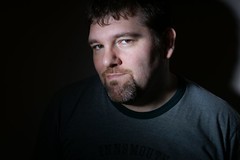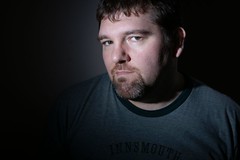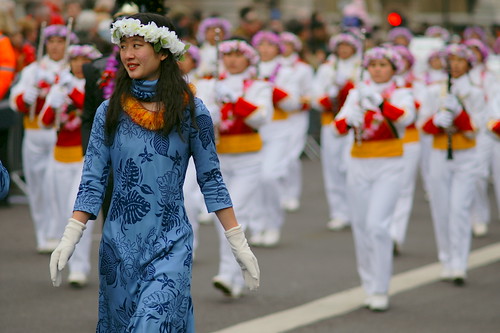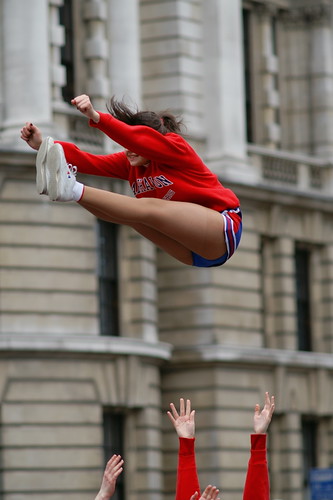Not wanting to leave grid design to chance, I decided to come up with some theory on how the beam spread of a snoot or grid could be predicted using a bit of trigonometry. The theory is that the light passes through an angle that is determined by the width of the aperture and its length. So for a given angle of light spread, you can choose to have a short grid with a small aperture, or a long grid with a large aperture.
If you know the angle of spread you want the grid to have and you know the width of the aperture, you can work out the length you need to make the grid, with the following equation.
Length = Aperture/Tan(Angle/2)
Or you may find these useful
Aperture = Length * Tan(Angle/2)
Angle = 2 * Atan(Aperture/Length)
To make life a little easier for you, I have put together a little calculator, that allows you to change any of the variables and will recalculate for you on the fly.
The checkboxes link variables, so that if you change a value in a box, then the one it is linked to, will be re-calculated. Hopefully it will help you avoid making grids that are too long or too short.
One of the things I have learnt from ths excercise is that I need to get out more and a deep and abiding hatred of javascript and css.
I haven't tested this thoroughly so if you find any bugs or have any suggestions please leave a comment. I'd also like to hear from you if it helped you build your grid
Thursday, 31 January 2008
Saturday, 26 January 2008
Ballet Class
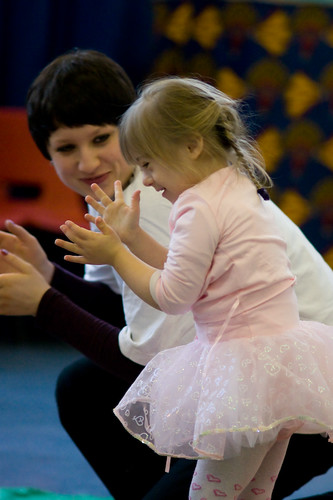
Last week, when I took my daughter to her ballet class, I brought my camera along and asked permission to take photos of the children. It was quite challenge as the light levels were quite low and the children fast moving, so I was working at ISO 1600 and 3200 with an f2.8 lens, but my new Sony A700 did an excellent job, with a bit of noise reduction in lightroom the picture quality looked great.
I got a bunch of 6x4s printed and took them along this week to hand out to the parents. The best thing was watching two parents lightheartedly fighting over which photos of their kids they would keep.
This photo is of my youngest, daughter Christina having fun with one of the assistants. ISO1600 f2.8 1/160s
Wednesday, 23 January 2008
Lunchtime Walks Gallery
My lunchtime walks are giving me one or two photographic opportunities. Given that I've almost walked the 4 square kilometers surrounding my office already, I'll be taking a bit more time to take photographs over the coming year.
I have setup a flickr set to display the pictures I take on my walks and I'll be showing them on this page.
Created with Admarket's flickrSLiDR.
I have setup a flickr set to display the pictures I take on my walks and I'll be showing them on this page.
Created with Admarket's flickrSLiDR.
More Grids
 Some time back strobist reader Rafael Motta posted a quick tutorial on how to make a softbox grid from fabric. If you have the patience to put one of these together click on the image for the instructions.
Some time back strobist reader Rafael Motta posted a quick tutorial on how to make a softbox grid from fabric. If you have the patience to put one of these together click on the image for the instructions.
Monday, 21 January 2008
How to make honeycomb grids
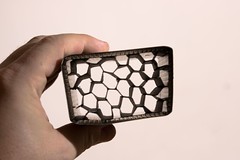 So far, for making grids, I have used drinking straws and coroplast. The straws have been the most successful so far, but I wanted to consider other methods, as neither the straws, nor the coroplast, have been particularly scaleable. So I had a go at making honeycomb grids.
So far, for making grids, I have used drinking straws and coroplast. The straws have been the most successful so far, but I wanted to consider other methods, as neither the straws, nor the coroplast, have been particularly scaleable. So I had a go at making honeycomb grids. All you need is some black card and glue, or double sided sticky tape. First decide how big you want your holes to be. If you are covering a large area, you might want to have big holes, as the bigger the hole the less work you have to do to construct it. For a smaller area you might want smaller holes. This construction method allows you to make grids with any sized hole you like. Bigger holes will let through more light, but they will also allow the light to escape over a wider angle, so if you make your hole bigger you will need to make your grid deeper to restrict the light.
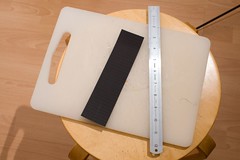 For a small grid, I chose a create the honeycombs a quarter of an inch long on each side of the hexagon. This makes the widest part of the hexagon approximately three eights of an inch wide. To keep the beam tight, I made the grid two inches deep. One A4 sheet of paper was enough to make the grid with plenty to spare.
For a small grid, I chose a create the honeycombs a quarter of an inch long on each side of the hexagon. This makes the widest part of the hexagon approximately three eights of an inch wide. To keep the beam tight, I made the grid two inches deep. One A4 sheet of paper was enough to make the grid with plenty to spare.
The first step is to draw lines a quarter of an inch apart with a ballpoint pen, parallel to the shortest side of the paper. Press hard enough to score the paper and make it easy to bend. Take care not to press so hard that it makes the paper tear. Then cut the paper into 2 inch strips, parallel to the longest side.
 Next you need to bend the paper into into honeycomb halves. Its basically two bends in one direction and two in the other, repeat until you have a nicely corrugated sheet of paper. Cut the paper in half, down the middle and match up the corrugations so that you have the beginnings of a honeycomb. You can use glue or double sided sticky tape to glue the adjoining faces together, I like the sticky tape because it is less messy. Rinse and repeat until you have made it big enough to fit in front of your flash head.
Next you need to bend the paper into into honeycomb halves. Its basically two bends in one direction and two in the other, repeat until you have a nicely corrugated sheet of paper. Cut the paper in half, down the middle and match up the corrugations so that you have the beginnings of a honeycomb. You can use glue or double sided sticky tape to glue the adjoining faces together, I like the sticky tape because it is less messy. Rinse and repeat until you have made it big enough to fit in front of your flash head.
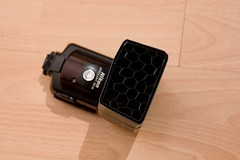 Finally, you will need to attach it to the flash I cut some coroplast to fit round the flash, and stuck the honeycomb inside it with doublesided tape. I then wrapped it in gaffer tape.
Finally, you will need to attach it to the flash I cut some coroplast to fit round the flash, and stuck the honeycomb inside it with doublesided tape. I then wrapped it in gaffer tape.
If you have something big you want to grid, you can make a big honeycomb, I built one for my 24cm gridspot, but with hindsight I should have made the grid a lot deeper to restrct the beam more. One day I will make a huge one to fit on an umbrella, just you wait and see.
 The small honeycomb grid performs about as well as the straw snoot. I think the light output is slightly stronger and the spot is slightly hexagonal compared to the circular spot produced by the straw grid. I found that the hexagonal grid was easier to construct than a straw grid and the parts more readily available. I also prefer the hexagonal spot to the square spot that the coroplast grid produced, but the coroplast snoot was much easier to construct.
The small honeycomb grid performs about as well as the straw snoot. I think the light output is slightly stronger and the spot is slightly hexagonal compared to the circular spot produced by the straw grid. I found that the hexagonal grid was easier to construct than a straw grid and the parts more readily available. I also prefer the hexagonal spot to the square spot that the coroplast grid produced, but the coroplast snoot was much easier to construct.
Where the honeycomb construction method really wins, is when you want to cover a large area. Its much easer to put together a big grid with a honeycomb than using straws or coroplast. But if you absolutely must have a circular spot, then you should use straws.
Saturday, 19 January 2008
Walk London at Lunchtime
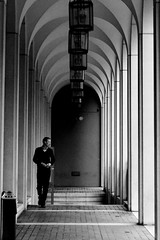 Of all my new years resolutions, this one has been the most successful and fruitful. Ive printed a map of an area centered on my office in Holborn and every day I stop for a bacon roll at a local Cafe and head off into the unknown.
Of all my new years resolutions, this one has been the most successful and fruitful. Ive printed a map of an area centered on my office in Holborn and every day I stop for a bacon roll at a local Cafe and head off into the unknown.
The area I'm covering is a square about 2 kilometers on each side centered on Holborn, and its surprising how much ground I've managed to cover in an hour per day. There are places that I know well and have been revisiting them and looking in the odd little side streets. I have discovered little shortcuts and alleyways that aren't on the map and places that I didnt really know existed.
As I go along, I have been noting the places of interest so that I can take a more leasurely look another time with my camera. It won't be long before I have literally been in every single street in the area.
Friday, 18 January 2008
It Would Never Happen With Digital
While I was waiting for the new camera to show up, I dusted off the Hasselblad, loaded up some film and set off to take some photos. I took some photos of Gandhi smoking a fag in Tavistock Square and finished the roll. So I wound the film onto the take-up spool and cracked open the film holder only to discover that I had loaded the film back-to-front! Doh!
Undeterred, I carefully loaded a fresh film and took some more shots... Doh! back-to-front again.
When was the last time you put a CF card in your camera the wrong way round?
Undeterred, I carefully loaded a fresh film and took some more shots... Doh! back-to-front again.
When was the last time you put a CF card in your camera the wrong way round?
Sunday, 13 January 2008
Blue Peter Extra Large Gridspot Part 3
The thing about experiments is that even the failures can be instructional, after finally getting my new camera and turning off Dynamic Range Optimisation. I took some shots of the light output.
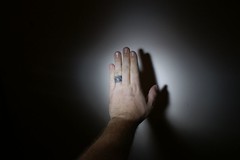 What the camera sees is quite different from what the eye sees. What had looked like a big well defined circle by eye, turned out to be almost square with a circular hotspot. I added some diffusion in front of the flash head and some more behind the grid and was able to get a more even coverage but it cut a fair amount of light.
What the camera sees is quite different from what the eye sees. What had looked like a big well defined circle by eye, turned out to be almost square with a circular hotspot. I added some diffusion in front of the flash head and some more behind the grid and was able to get a more even coverage but it cut a fair amount of light.
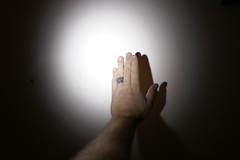 The other thing I realised was that the grid I had been comparing it to in part one, was quite a long one, but the 24cm grid is only one inch deep, consequently the light was able to spread more, so the comparison wan't entirely fair. I compared it instead, with a short grid made out of drinking straws.
The other thing I realised was that the grid I had been comparing it to in part one, was quite a long one, but the 24cm grid is only one inch deep, consequently the light was able to spread more, so the comparison wan't entirely fair. I compared it instead, with a short grid made out of drinking straws.
The drinking straw grid produced a larger brighter circle which was very clearly circular, unlike the 24cm gridspot which was distinctly square. Why were the shapes so different? I think it is because the square section of the coroplast allowed the light to escape at a wider angle on the diagonals, but on the straw grid the angle is the same in every direction. I think it would be an interesting experiment to try different shaped grids to see what sort of pool of light they produce.
So far it wasn't looking very promising, the size, shape and power of the light wasn't very good. But did it do what it was designed to do? Did it soften the light?
So grudgingly, I have to conclude that the humble straw grid outperforms the gridspot in pretty much all areas. Its a great deal more convenient to take with you too. But I did learn a few things from this experiment.
1. The light source has to be a lot bigger to soften the light. 2. The shape of the holes in the grid affects the shape of the spot 3. The small straw snoot rocks
 What the camera sees is quite different from what the eye sees. What had looked like a big well defined circle by eye, turned out to be almost square with a circular hotspot. I added some diffusion in front of the flash head and some more behind the grid and was able to get a more even coverage but it cut a fair amount of light.
What the camera sees is quite different from what the eye sees. What had looked like a big well defined circle by eye, turned out to be almost square with a circular hotspot. I added some diffusion in front of the flash head and some more behind the grid and was able to get a more even coverage but it cut a fair amount of light.
 The other thing I realised was that the grid I had been comparing it to in part one, was quite a long one, but the 24cm grid is only one inch deep, consequently the light was able to spread more, so the comparison wan't entirely fair. I compared it instead, with a short grid made out of drinking straws.
The other thing I realised was that the grid I had been comparing it to in part one, was quite a long one, but the 24cm grid is only one inch deep, consequently the light was able to spread more, so the comparison wan't entirely fair. I compared it instead, with a short grid made out of drinking straws.
The drinking straw grid produced a larger brighter circle which was very clearly circular, unlike the 24cm gridspot which was distinctly square. Why were the shapes so different? I think it is because the square section of the coroplast allowed the light to escape at a wider angle on the diagonals, but on the straw grid the angle is the same in every direction. I think it would be an interesting experiment to try different shaped grids to see what sort of pool of light they produce.
So far it wasn't looking very promising, the size, shape and power of the light wasn't very good. But did it do what it was designed to do? Did it soften the light?
Comparing the straw grid with the 24cm grid showed the that light was slightly softer, but the edge transition wasn't great and it wasn't a great deal softer. It was possible to tell the difference with a small object like my hand, but with something bigger, like my head, the difference between the two grids was negligable.
One final observation was to do with handling, after a while the 24cm grid started to droop a bit as the duct tape heated up from repeated flashes. This didn't seem to affect the light quality particularly, but it affected positioning. The grid also started to lose its grip on the dish and needed a bit more tape to hold it together. It also doesn't fit conveniently in a kit bag.
So grudgingly, I have to conclude that the humble straw grid outperforms the gridspot in pretty much all areas. Its a great deal more convenient to take with you too. But I did learn a few things from this experiment.
1. The light source has to be a lot bigger to soften the light. 2. The shape of the holes in the grid affects the shape of the spot 3. The small straw snoot rocks
Tuesday, 8 January 2008
Blue Peter Extra Large Gridspot Part 2
 This is part 2 of how I built a 24cm grid spot for my small hot-shoe flash gun. In part 1, I explained what I wanted to achieve. In this part, I'm going to show you how I turned this tasty bowl of chocolatey goodness, into a lighting modifier for small off-camera flash.
This is part 2 of how I built a 24cm grid spot for my small hot-shoe flash gun. In part 1, I explained what I wanted to achieve. In this part, I'm going to show you how I turned this tasty bowl of chocolatey goodness, into a lighting modifier for small off-camera flash.
Ingredients:
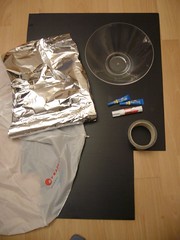
1 M&S Profiterole desert
1 A2 Sheet of black coroplast
1 Roll of Black Duct Tape
1 Sheet of tin-foil
1 Sheet of diffusion material (optional)
1 Strip of sticky backed velcro hooks
Cardboard
The first step is to eat all the profiteroles. You may want to get a grown-up to help you. I would also recomend you have a lie down for a while afterwards.
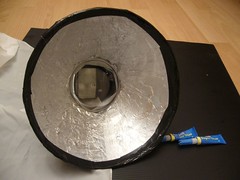 The bowl is transparent, so we are going to shoot through the bottom of it. Because I was hoping the plastic of the bowl would diffuse the light a little all by itself, I decided to wrap tin foil on the outside. I used a 3M Glue stick to stick the foil on, and then coated the outside with black duct tape, with a little overlapping on the inside to hold the tin foil down. Make sure you leave a clear area at the bottom of the bowl for the flash to shine through.
The bowl is transparent, so we are going to shoot through the bottom of it. Because I was hoping the plastic of the bowl would diffuse the light a little all by itself, I decided to wrap tin foil on the outside. I used a 3M Glue stick to stick the foil on, and then coated the outside with black duct tape, with a little overlapping on the inside to hold the tin foil down. Make sure you leave a clear area at the bottom of the bowl for the flash to shine through.
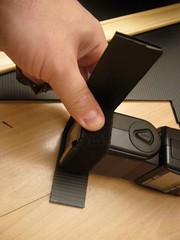 The next step, is to create an attachment for the flashgun. I used some of the coroplast to create an open ended box to attach to the bottom of the gridspot. Unlike Rui over at the Lighting Mods Blog I am very imprecise with my DIY, I didn't measure anything, I just offered up the flashgun to the coroplast and folded it round. To make the coroplast bend you just have to cut through the wall on the outside of the place where you want it to bend and it will give you a nice sharp bend.
The next step, is to create an attachment for the flashgun. I used some of the coroplast to create an open ended box to attach to the bottom of the gridspot. Unlike Rui over at the Lighting Mods Blog I am very imprecise with my DIY, I didn't measure anything, I just offered up the flashgun to the coroplast and folded it round. To make the coroplast bend you just have to cut through the wall on the outside of the place where you want it to bend and it will give you a nice sharp bend.
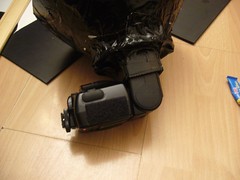 Once the coroplast is cut to size you can put it around the flashgun and tape the loose ends together. Then tape it to the bottom of the bowl, making sure that none of the bowl is visible. At this stage I put some velcro hooks on the inside of the coroplast box at each of the short ends. This made the fit with the flashgun tighter and held it in place. Make one piece of velcro shorter than the other, or you might find it a little difficult to remove the gun once its in place.
Once the coroplast is cut to size you can put it around the flashgun and tape the loose ends together. Then tape it to the bottom of the bowl, making sure that none of the bowl is visible. At this stage I put some velcro hooks on the inside of the coroplast box at each of the short ends. This made the fit with the flashgun tighter and held it in place. Make one piece of velcro shorter than the other, or you might find it a little difficult to remove the gun once its in place.
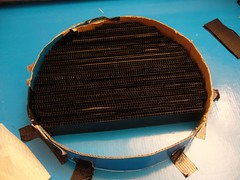 The most tedious part comes next, its creating the actual grid. I traced the outline of the bowl onto some cardboard as a guide and then cut a strip of cardboard about 1.5 inches wide, which I taped on its edge around the circle. I cut 1 inch strips of coroplast to fit inside the circle and glued them together, until I had filled the circle. I used superglue because that what I had available, but it isn't really practical, you would would probably be better off using something that sets a little more slowly. Once the coroplast was all fitted together, I put some duct tape around the cardboard to hold the grid in place. Now the grid has a lip all around it that can be used to fit around the front of the bowl. If its a loose fit, just add more duct tape until it all fits together firmly.
The most tedious part comes next, its creating the actual grid. I traced the outline of the bowl onto some cardboard as a guide and then cut a strip of cardboard about 1.5 inches wide, which I taped on its edge around the circle. I cut 1 inch strips of coroplast to fit inside the circle and glued them together, until I had filled the circle. I used superglue because that what I had available, but it isn't really practical, you would would probably be better off using something that sets a little more slowly. Once the coroplast was all fitted together, I put some duct tape around the cardboard to hold the grid in place. Now the grid has a lip all around it that can be used to fit around the front of the bowl. If its a loose fit, just add more duct tape until it all fits together firmly.
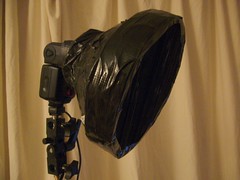 The proof, they say, is in the pudding, unfortunately I don't have a working digital camera at the moment so I can't show you examples of the results, but I should be getting my new camera in a few days, so wait until part three and I'll show you what it can do.
The proof, they say, is in the pudding, unfortunately I don't have a working digital camera at the moment so I can't show you examples of the results, but I should be getting my new camera in a few days, so wait until part three and I'll show you what it can do.
However I have done some tests with a light meter and test fired to see how well it works.
I placed the flash about 6 foot from the wall at full power. With the grid spot,it produced a fairly well defined circular spot on the wall about 1.5 feet in diameter. I used the built in diffuser on the flash to set the zoom at 18mm
At ISO100 1/400s I get f4.5 in the center f3.5 at the edge. I had thought a little bit of diffusion between the grid and flash would help to sharpen up the edges, but the loss of a stop of light just wan't worth the bother. Next I set the flash to zoom to 85mm, this yielded a spot that was nearer 1 foot in diameter with a much more gradual drop-off. At ISO100 1/400s I got f5.0 in the center
Compared to a small flash grid it doesn't lose all that much light and it gives a much better defined source, which is of course also bigger. I can't wait to try this out when the new camera arrives.
You can click on any picture to see them on Flickr with additional notes
Saturday, 5 January 2008
Blue Peter Extra Large Gridspot Part 1
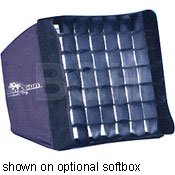 If, like me you have a very small area to work in, you might want a light source that's big and soft but also very directional, so that it doesn't bounce around and light up the room.
If, like me you have a very small area to work in, you might want a light source that's big and soft but also very directional, so that it doesn't bounce around and light up the room.
What would be ideal would be an eggcrate. Eggcrates are panels made from a black material that splits the area of a softbox into square sections. The sides of these sections act like straws in a straw snoot to restrict the light. My ambition is to build a collapsible eggcrate for my silver umbrella, but thats going to be a bit of a long term project, alternatively Westcote among others sell eggcrates that will fit on your softbox.
 Anyway, I digress. Eggcrates being out of scope for the present, I thought I would try building something using materials that I had to hand. Having enjoyed one or two bowls of profiteroles from Marks & Spencer's over christmas, I had a surplus of plastic bowls. I also had an A2 sheet of black coroplast, which I had been using to make small grids with. I thought I would make a grid out of the coroplast that was 24cm in diameter, which would fit over the end of the bowl. Add a bit of diffusion to scatter the light internally so that it reaches the edges and you have a 24cm tight beam of light. At least thats the theory.
Anyway, I digress. Eggcrates being out of scope for the present, I thought I would try building something using materials that I had to hand. Having enjoyed one or two bowls of profiteroles from Marks & Spencer's over christmas, I had a surplus of plastic bowls. I also had an A2 sheet of black coroplast, which I had been using to make small grids with. I thought I would make a grid out of the coroplast that was 24cm in diameter, which would fit over the end of the bowl. Add a bit of diffusion to scatter the light internally so that it reaches the edges and you have a 24cm tight beam of light. At least thats the theory.
Tune in for part two and I'll show you how to build it.
Creative Lighting Techniques for Studio Photographers

Though much of what is presented is pertinent to flash photography, the really surprising stuff is in the use of continuous light sources, if you are into product photography this stuff will be very useful to you.
I'd recommend it as a complement to Light Science and Magic.
Friday, 4 January 2008
Good Composition
This year I'm going to put as much effort into composition, as I have into lighting in the last. I want to make my photos a bit more complex. So I will be seeking out blogs and web sites that talk about composition.
My first foray unearthed David Tejada's musings on composition in his blog post, What makes good composition
What I like about this article is the way that David graphically decomposes the compositional elements in his photos, by selectively washing out different areas.
I did a little hunting around and found something similar for artists Composition - Understanding it - Using it by Larry Seiler.
What you might notice is that the principles are the same, but Larry uses a formal vocabulary for describing compositional controls.
Now there's a thought. Could we have a blog tutorial like The Strobist's Lighting 102 I'd love to do something like that only I haven't achieved anything approaching guru status... yet.
My first foray unearthed David Tejada's musings on composition in his blog post, What makes good composition
What I like about this article is the way that David graphically decomposes the compositional elements in his photos, by selectively washing out different areas.
I did a little hunting around and found something similar for artists Composition - Understanding it - Using it by Larry Seiler.
What you might notice is that the principles are the same, but Larry uses a formal vocabulary for describing compositional controls.
Now there's a thought. Could we have a blog tutorial like The Strobist's Lighting 102 I'd love to do something like that only I haven't achieved anything approaching guru status... yet.
Thursday, 3 January 2008
New Years Day 2008
This new year's day was an interesting one. My 70-210 f4 lens is in for repair and I really dislike my 28-75 f2.8 because it is a bit rubbish at f2.8. So I made the shock decision to just use two primes. The 50 f1.4 and the 135 f2.8.
Using primes on an event like this is quite tricky because its often quite fast moving and because you have to shoot from a static position there is very little opportunity for reframing. But the extra light those two lenses gave and the fabulous bokeh and sharpness made up for it. The extra light meant I could use ISO 100 and still get fast enough shutter speeds to keep everything crisp.
To add to the challenge the autofocus wasn't coping very well with the moving targets so I used manual focus all the way through.
There didn't seem to be quite as many bands and floats as in 2006 and our home grown parade participants just didn't seem to put much effort into it. Guys, if you are reading, a matching set of tracksuits and a handwritten sign does not make a thrilling parade. People want to see colourful costumes, some tumbling and perhaps some mild peril.
Using primes on an event like this is quite tricky because its often quite fast moving and because you have to shoot from a static position there is very little opportunity for reframing. But the extra light those two lenses gave and the fabulous bokeh and sharpness made up for it. The extra light meant I could use ISO 100 and still get fast enough shutter speeds to keep everything crisp.
To add to the challenge the autofocus wasn't coping very well with the moving targets so I used manual focus all the way through.
There didn't seem to be quite as many bands and floats as in 2006 and our home grown parade participants just didn't seem to put much effort into it. Guys, if you are reading, a matching set of tracksuits and a handwritten sign does not make a thrilling parade. People want to see colourful costumes, some tumbling and perhaps some mild peril.
The american girls were out there having the time of their lives performing in the freezing cold, wearing miniskirts and performing feats of acrobatics that had me fumbling for the delete button on my camera, lest I get found with images of young girls legs akimbo flashing their knickers.
The English girls on the other hand were in scarves and tracksuits with expressions of pure misery, flinging the occasional baton in a desultory manner and complaining to their guardians about the cold or having to walk or something.
If the Americans stopped coming there would be no parade. Click any of the images to see the full set.
Wednesday, 2 January 2008
Disaster
As soon as I make my new year's resolution, disaster strikes. My Digital SLR has died. Ok so it hasn't completely died, but none of controls work and the camera is stuck in AEL mode, which means I can still shoot with flash as long as I adjust the flash power to match the metering on the camera, but that's not terribly convenient. So this means I'm going to have to order a new camera as I would be surpised if I can get the camera repaired in time for my honeymoon in Iceland.
Of course this means that my picture a day will have to be taken using the Hassleblad or my Dynax 7, which means I won't be posting the results very frequently. There will be no more strobist chimping either, I'll have to use a light meter. I can't even use my old Olympus, because that died a couple of months ago.
To cap it all, Virgin Merda still haven't fixed my internet connection, so ordering a camera online or updating this blog will be challenging to say the least.
Of course this means that my picture a day will have to be taken using the Hassleblad or my Dynax 7, which means I won't be posting the results very frequently. There will be no more strobist chimping either, I'll have to use a light meter. I can't even use my old Olympus, because that died a couple of months ago.
To cap it all, Virgin Merda still haven't fixed my internet connection, so ordering a camera online or updating this blog will be challenging to say the least.
Tuesday, 1 January 2008
New Year's Resolutions
I haven't made a new year's resolution since I was about 16 years old. So I figure that means that I should make at least 22 new years resolutions to catch up.
Looking back over the last year of photography, its clear to me that I haven't taken enough pictures, I need to get out with the camera a lot more. I need to put all the techniques and skills I have aquired into practice and I need to be more structured in my ongoing photographic education. Another thing I need to do is to concentrate more on composition and take shots that I wouldn't normally take, the lighting technique has been getting in the way of this a little. By shooting more, I make the lighting technique become second nature and concentrate on what really matters.
So here are my new years resolutions in no particular order.
Ok so thats just 12 resolutions, lets see how many I'll be able to keep and maybe I'll add a few more.
Looking back over the last year of photography, its clear to me that I haven't taken enough pictures, I need to get out with the camera a lot more. I need to put all the techniques and skills I have aquired into practice and I need to be more structured in my ongoing photographic education. Another thing I need to do is to concentrate more on composition and take shots that I wouldn't normally take, the lighting technique has been getting in the way of this a little. By shooting more, I make the lighting technique become second nature and concentrate on what really matters.
So here are my new years resolutions in no particular order.
- Take a photograph every day: I'll be posting these on this here blog. I'll be using my lunchbreaks for this.
- Take a portrait every week. This one might be tricky, as I don't want to do a self portrait every week and my family will soon lose patience, so I'm going to have to accost people on the street.
- Hold a Work Photography day once per month. I have been running photography sessions every other month at work, I want to do this at least once per month.
- Talk to my local bar about photographing bands. There is live music at the end of my road almost every night, I should have a word and see if they will let me in for a few minutes everynight to photograph the bands. It would also be a great location for shooting environmental portraits.
- Walk London at lunchtime: I work in Holborn and can get as far as St Paul's and back in my lunch hour. I'm going to attempt to visit every road within walking distance of my office. I may need a map :)
- Use the blad: I have a Hassleblad, which has been woefully neglected, I need to use it more
- Complete a project: I will go through some ideas for projects I have and follow through with one. The aim would be to produce a coherent body
- Submit a story to Jpeg magazine: This could go hand in hand with the project
- Re-read all my photography books: So many good books, I need to go back through them again and be inspired.
- Light Science and Magic: I will go through this book and treat it as a series of excercises to master the techniques.
- The Big Shoot: I miss the thrill of the big shoot, I need to organise some with MUAs and stylists
- Be an assistant: I feel I get a lot out of assisting other photographers, I will do a few assisting jobs
Ok so thats just 12 resolutions, lets see how many I'll be able to keep and maybe I'll add a few more.
Subscribe to:
Comments (Atom)

